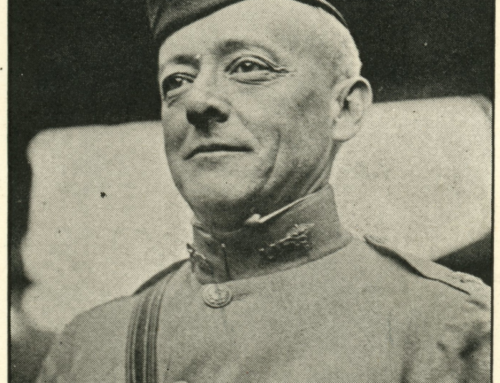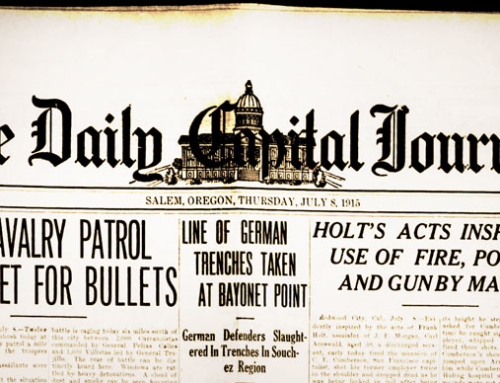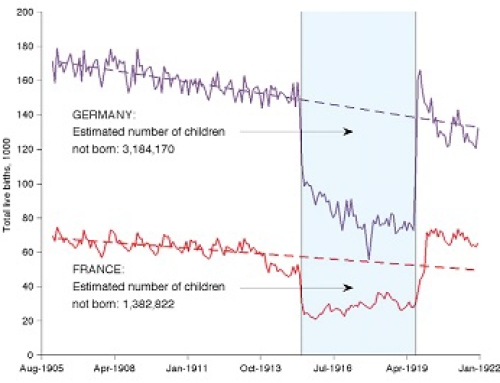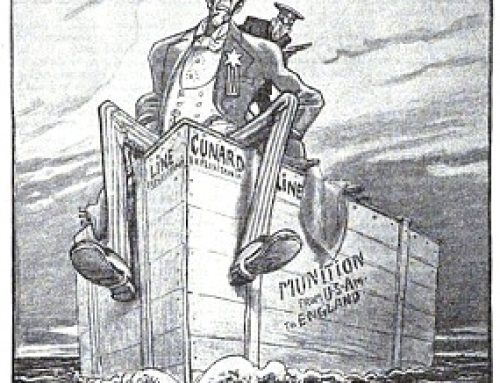by Richard van Pelt, WWI Correspondent
In an editorial redolent of allegory, the Oregon Statesman writes of the futility of war when alternatives exist:
The Bodies of Men
“Men’s bodies are our women’s works of art,” says Olive Schreiner in “Women and Labor.”
“In a besieged city it might well happen that men in the streets might seize upon statues and marble carvings from public buildings and galleries and hurl them in to stop the breaches made in their ramparts by the enemy, unconsideringly and merely because they came first to hand, not valuing them more than had they been paving stones. One man, however, could not do this – the sculptor. He who, though there might be no work of his own chisel among them, yet knew what each of these works of art had cost, knew by experience the long years of struggle and study and the infinitude of toil which had gone to the shaping of even one limb, to the carving of even one perfect outline; he could never so use them without thought or care. Instinctively he would seek to throw in household goods, even gold and silver, all the city held, before he sacrificed its works of art.
“Men’s bodies are our women’s works of art. Given to us power to control, we will never carelessly throw them in to fill up the gaps in ambitions and greeds. The thought would never come to us as women. ‘Cast in men’s bodies; settle the thing so!’ Arbitration and compensation would as naturally occur to her as cheaper and simpler methods of bridging gaps in national relationships as to the sculptor it would occur to throw in anything rather than statuary, though he might be driven to that at last!”
Two recent news dispatches from the war are impressive in view of that statement.
One is that German school boys of ages between 15 and 17 are now being drilled for the war. It is expected that they will be sent out in the spring. At that time, after a winter’s thorough German drill in military system, a winter’s thorough German preparation to kill their fellow men, many of them will be under 16, all less than 19.
“Cast in men’s bodies; settle the thing so!”
The other reads thus” “The Bundesrath (a national council) of Germany has decided, says a Reuter’s dispatch from Amsterdam, to furnish financial and medical assistance to women at the time of childbirth. This step was taken to alleviate the anxiety of husbands at the front to protect the coming generation.”
To protect the coming generation! For what?
“Companies of German school boys between the ages of 15 and 17 are being drilled —-“
“Cast in men’s bodies; settle the thing so!”
A headline on the front page describes the state of the Navy:
DEVELOPING OF THE NAVY WILL TAKE 5 YEARS
Fiske Tells of Deficiency of Air Craft, Ships and Men
U. S. NEEDS SUBMARINES
American Gunnery Excelled by Foreign Navy
Admiral Expresses Doubt as to Whether American Navy could Be Made as Efficient as Those of Europe in Five Years – Panama Canal Not Invulnerable.
Confusing and contradictory headlines leave readers confused:
SAYS VICTORY IN POLAND IS WAR’S GREATEST
Berlin Report Declares Russians Used Last Available Men
WILL AFFECT BALKANS
Morale of Russians Blamed for Defeat
Petrograd Reports Beaten Germans Are Being Pursued in Direction of Mlawa – Sorties from Przemsyl Result In Heavy Losses to Garrison in Men and Equipment
The headlines in the Capital Journal were no less contradictory, the most trustworthy being those articles written by an eyewitness:
GRAPHIC STORY OF AUSTRIAN RETREAT BY ONE WITH THEM
Victorious Army changed in a Day to Staggering Disorganized Mass
ROAD MARKED WITH THE DEAD AND DYING
Austrian Outrages Drove the Servians to Fury and Caused the Disaster
(By William G. Shepherd)
London, Dec. 18 – -The route of the Austrian retreat from Servia was a path of horror.
I was with the Hapsburg forces during their precipitate retirement.
The road they travelled was marked by the bodies of dead and dying soldiers by the wrecks of wagons and by the still worse wrecks of men driven insane by their sufferings.
I saw the Austrian army transformed almost in a day from a body of conquerors into a staggering, disorganized mass. Its retreat was a rout.
After spending weeks in France and Belgium, after observing the German troops in the field and after watching the fighting at Przemsyl, it was in Servia that I beheld the most horrible scenes of the war.
I arrived in Servia following many weeks with the Austrian army in Galicia, where I had witnessed the soldiers’ heroic attacks and defense in the campaign against the Russians.
The Servian campaign was different.
Austrians Inhuman
Perhaps the Austrians’ long smoldering hatred of the Servians, coupled with their belief that Servian plotters arranged and executed Archduke Francis Ferdinand’s assassination, was responsible for this difference.
Austrian outrages in Servia have been worse than those charged against the Germans in Belgium.
For 40 miles from the frontier the country is deserted and as silent as the tomb. Hundreds of residents of Servian towns have been executed.
November 15 the Austrians took the correspondents then with their army into Servia to show them how the enemy’s lines were being driven back.
We travelled 150 miles into the northwestern corner of the country. Eighteen towns which we passed were utterly deserted. In every one I saw one or two walls marked by the bullets fired at the execution of inhabitants.
Austrian and Hungarian officers denied that women had been executed but admitted that such a fate had befallen hundreds of men.
Hanged Prisoners
One Hungarian officer showed me a six foot pole which he said he used in his killings. He explained that he set this pole upright, fastened a rope to the upper end, forced his Servian victim to sit in a chair, adjust the free end of the rope about the man’s neck and then knocked the chair from under him.
“He was usually dead” commented the officer, “in eight or ten minutes.”
I saw 25 square miles of Servian trenches of perfect pattern in which the bodies of Servians were rotting. They had been denied even decent burial.
The Austrians promised with great jubilation to take us into Belgrade November 25. But their plans were suddenly changed.
We were hurried out of Servia in wagons. There was no explanation. After leaving the wagons we were loaded onto a train and taken to Budapest. There huge wagon trains filled the roads. In them were madmen and wounded.
And then we discovered the Servians were advancing.
Blizzard Adds to Horror
We had been taking part in a retreat – in an utter rout.
The country was being swept by a terrific blizzard the day we left Servia. The roads were in an unspeakable condition. The hardships of travel were fearful.
It was as if Belgium should arise suddenly and drive out the Germans.
The statement that many soldiers went insane is not exaggeration.
In one case an Austrian lieutenant, lying wounded by the roadside, saw the major of his own regiment riding by and called to him, whereupon the major turned and shot him in the leg. He was stark mad.







Leave A Comment